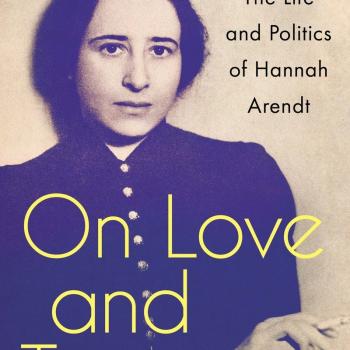Do you cry over movies? Me too. I admit it: the endings of Field of Dreams and Shawshank Redemption get me every time, even though I’ve seen each a dozen times or more.
Good to recall: even Jesus wept.
How about holiday movies? Last night we saw Joyeux Noel: not for the faint of heart, I assure you. But it’s hard not to get choked up to see how one soldier embraces his dead brother on the battlefield. Or to see the rapt faces of the soldiers from different sides of the horrific trench warfare of WW I, coming together to listen to skilled operatic singers.
There is something unusually visceral about these and other cinematic moments. Some have argued that we encounter God or the Transcendent at the cinema, provoking intense emotional response. In his recent book God’s Wider Presence, Robert K. Johnston argues that the “movie event” is uniquely tailored for weighty experiences of this sort (42-66). The pathos of film experience is such that it can even bring a person to tears over a fictional character. And the characters don’t have to look real: as in the case of the shooting of the mother of Bambi; or the beginning of Up; or the end of Toy Story III. Even animated characters can cause adult viewers to weep. Sometimes, we weep for joy: provoked by the flickering motion pictures before us, we sense an almost sublime expression of hope, seated in a darkened theater and surrounded by strangers.
Back in the ice age before digital media and moving pictures, it was fiction that caused folks to get out the hankies. Perhaps we might tweak Johnston’s concept to discuss the “novel event” as a site for encountering “God’s wider presence.” Americans congregated on the docks of shipyards awaiting the latest installments of many of Charles Dickens’ novels. They certainly cried together in circles around the fireplaces of New England, as the elders took turns reading aloud from such works as Little Dorritt or Hard Times. The death of Little Nell in The Old Curiosity Shop was a particularly tearful episode, commented on frequently in letters and diaries.
But why such powerful emotions, given that these are all made-up tales of non-existent beings? How is it that the lives of characters that we know to be fictional can make us so aggrieved?
Several years ago, Tyler Beane’s brief meditation on A Christmas Carol appeared in The Cresset. Beane’s emphasis was on the elements of horror deployed by Dickens: the tale’s inherent darkness. Somehow, in describing a film adaptation’s image of the two destitute children “Ignorance” and “Want,” “The horror of the scene awakens one’s conscience.”
But one person’s horror can easily become another person’s sympathy. And in the Christian tradition of ars moriendi—the art of dying—it is through a deepened awareness of death and dying that one is capable of learning to live well. Emily Dickinson wrote powerfully of the value of an “ars moriendi outlook” for our everyday lives: “that Ethereal gain/ One earns by measuring the Grave–/ Then – measuring the Sun –.” Here Dickinson’s notion reminds me of one of my favorite moments in the Rule of Benedict: “Yearn for everlasting life with holy desire. Day by day remind yourself that you are going to die.”
In fact, nineteenth-century people were a lot less squeamish about death than most Americans in 2019 are. If you were born in 1850s America, your life expectancy was around 38 years. People “laid out” the bodies of the dead in their homes; often crafted their own coffins; and every week thereafter, as they entered and departed their local churches, they would pass by the gravestones marking the burial location of their dearly beloved.
I believe the spirit of St. Benedict’s injunction is basically healthy, despite the immediate modern allusions to the likes of Woody Allen, whose neurotic whining seems too obsessed with death. By way of contrast, Benedict presents a calm yet strong sensibility of our own mortality as somehow beneficial to our spiritual lives. Memento mori: remember that you are going to die. As scripture puts it, “teach us to number our days” (Psalm 90:12). Elsewhere sister Emily writes, death is “as harmless as a bee, except to those who run.” But Dickens is often more interested in those who run, and for them, death is deeply terrifying.
This element of running from the reality of death as universal is a key motif of the world of A Christmas Carol. Scrooge succeeds in learning through the lens of seeing his own impending death as a very bad one, but he appears to have no agency in bringing about any of his revelations. The visits of the spirits are sovereign experiences about which Scrooge has no choice. While St. Benedict invites us to think daily about our own impending deaths, Dickens assures us that many of us fail to do so—and in fact, dash speedily away from any deathly confrontation, like picnickers running from a disturbed beehive.
Once confronted, however, Scrooge is utterly transformed. Most readers probably want to believe that a hardened unbeliever like Scrooge can change dramatically, but some have serious doubts. Probably those who respond most powerfully to A Christmas Carol are readers and viewers who already embrace a supernatural account of God’s transcending hope that even the most wicked of individuals can be converted. “Why show me this, if I am beyond all hope?” Scrooge asks the final ghost. Dickens’ narrative shows that nobody, not even Scrooge, is beyond supernatural hope. To some large extent, this sort of hope constitutes the Christmas story.
In addition, neuroscience is now indicating we are not suspending belief at all, in accepting Scrooge’s radical change: deep emotion over fictive characters as opposed to real people is not some different, learned behavior. It turns out that my brain is reacting as if these are real people in real circumstances, as neuroscientist Jeffrey M. Zacks has recently shown in his book Flicker: Your Brain on Movies. That’s why we “jump” when the villain suddenly appears behind a door or curtain in a horror film. The same parts of the brain fire, as if it were a real murderer. And when we cry, our brains fire the same as if it were a real friend or family member. It’s all good moral formation, leading to sympathy.
Can we gain wisdom from fictional characters? Returning to the motif of an “ars moriendi outlook” for everyday life: what’s the takeaway for rereading A Christmas Carol? Readers (and viewers of the film versions) may miss the profound yet simple trinity of advice Dickens presents about what Scrooge has learned. First, Marley screams at Scrooge, “Mankind was my business. The common welfare was my business” (49). Don’t overlook our common lot, he begs Scrooge, who later will become like an uncle to the ailing Tiny Tim.
Second: we must live all day, every day, with an invigorated sense of time. Recall that the three ghosts represent the three aspects of time. Scrooge proclaims, “I will honour Christmas in my heart, and try to keep it all year. I will live in the Past, the Present, and the Future. The Spirits of all Three shall strive within me” (110). Note the capitalization: an emphasis that signals the keystone importance of these spirits and what they represent. As on the Sabbath, we are to look back at the week, embrace the present moment of God’s wider presence, and look forward. Christmas thus becomes not an annual festival but a daily, life-giving attitude combining retrospection, contemplation, and hope for the future.
Third: one must laugh. Scrooge, who never laughs before his experience, suddenly becomes “as light as a feather, as happy as an angel, I am as merry as a school-boy. I am as giddy as a drunken man” (111). As in Proverbs 17:22, laughter is a good medicine. The narrator chimes in: “for a man who had been out of practice for so many years, it was a splendid laugh, a most illustrious laugh” (112).
Though it may seem like just a funny line, I corroborate the idea of practice here. Use it or lose it: keep laughing, or any of us may fall out of practice. And just how good a laugher are you, dear reader? Do you try to laugh long and hard every single day, as if it were Christmas? Are you still able to become “as merry as a school-boy. … as giddy as a drunken man”? One of the great cinematic illustrations of this is when Patrick Stewart begins laughing hysterically in his performance as Scrooge: it’s over the top silly, but I think Stewart’s manic performance of glee, after nearly choking to death, is terrifically moving: a moment of transformation that is true to the spirit of the tale.
Personally, I practice laughing everyday—possibly to the annoyance of some colleagues and friends. This may be the hidden gem of the trinity of moral lessons in A Christmas Carol: laugh like a merry school-boy, and don’t fall out of practice.
Meanwhile: cry away too, folks. Crying at the movies, like laughing, is a sign of emotional health: both acts remind me that my brain is functioning in an emotionally healthy way. The crying signals my continuing commerce with those vagabonds named Ignorance and Want hiding under the folds of Death’s robe. And weeping, like laughing, requires practice too. We can even weep for joy, seeing Tiny Tim hoisted onto Scrooge’s shoulders. Think of the remarkable conjoining of terms in that phrase: weeping for joy. It sounds otherworldly—and it is, in fact.
So beware lest we fall out of practice of either mode of expression—laughing or weeping. One of the genius accomplishments of well-balanced narratives like A Christmas Carol is that they allow us to practice both. It turns out, we need all the practice we can get. And, like those Benedictines, it keeps us humble, as “Day by day [you] remind yourself that you are going to die”
Photo by Aliyah Jamous on Unsplash











